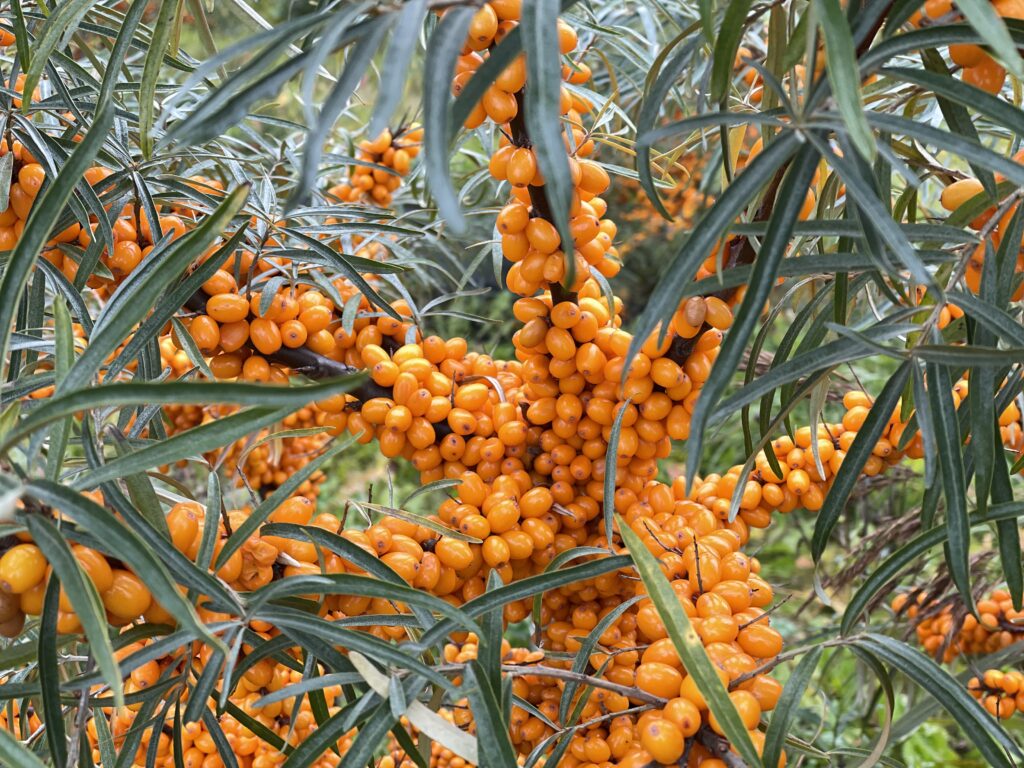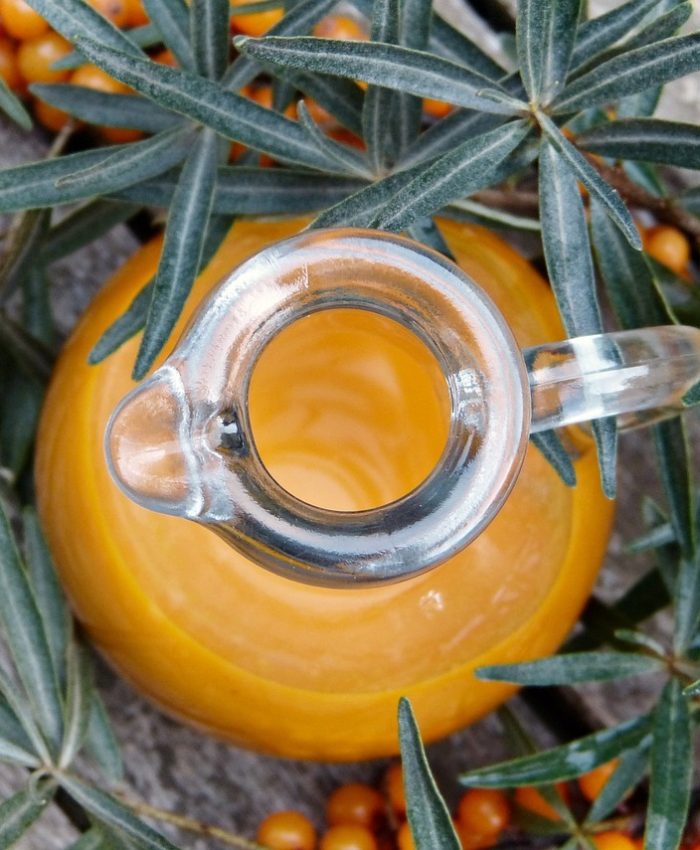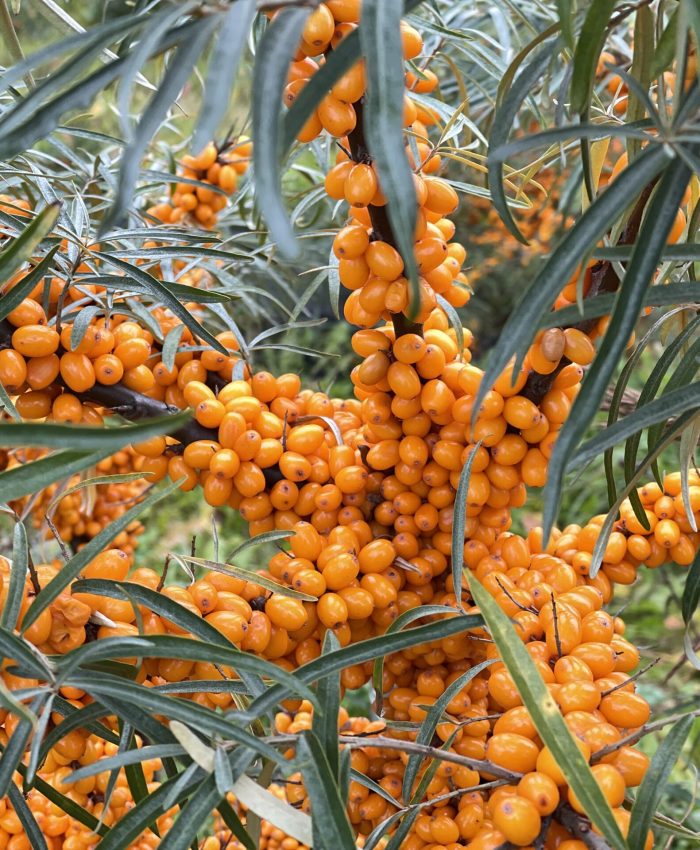Historical and Cultural Significance
First documented in China during the Tang Dynasty for its remarkable pharmacological properties, sea buckthorn (Hippophae rhamnoides) has gained popularity in recent decades as a “super berry” in the Western world. Once a little-known wild fruit, sea buckthorn now grows widely beyond its native habitat, including in Western Europe and North America. Increased interest in sea buckthorn benefits has led to growing scientific exploration and broader use in food, wellness, and research contexts.
For centuries, people in Central and Southeast Asia have highly valued sea buckthorn as a bioresource. They have used every part of the plant in traditional medicine, as food, fuel, and animal fodder. The plant’s Latin name, Hippophae, comes from hippo (meaning “horse”) and phaos (meaning “shine”). This name originates from ancient Greece, where sea buckthorn leaves and branches were fed to livestock, leading to healthier animals with shiny coats—especially horses.
Beyond its traditional use in China and Mongolia, sea buckthorn has played a significant role in Russia and the Himalayan region. Traditional practices have used sea buckthorn to address various ailments, including skin conditions, jaundice, asthma, digestive disorders, and rheumatic diseases. In Europe, manufacturers and herbalists have also incorporated the berries into herbal preparations, health foods, and natural skincare products.
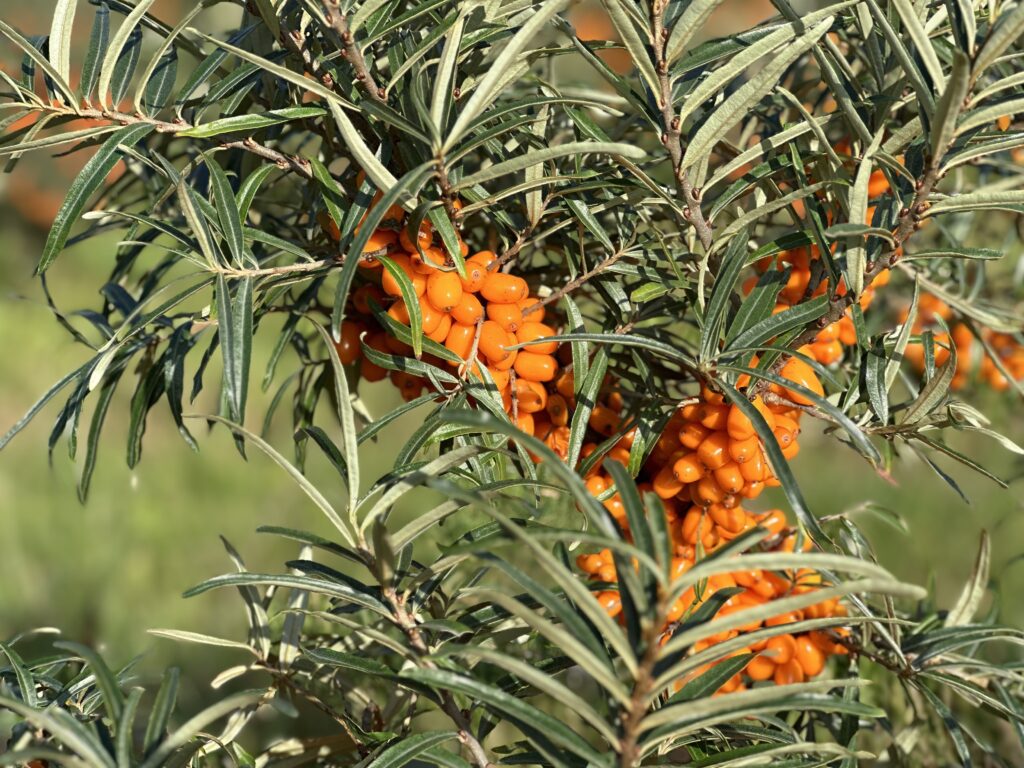
Sea Buckthorn. Hippophae rhamnoides.
Sea Buckthorn Benefits and Chemical Composition
In recent decades, the chemical properties of sea buckthorn have been extensively studied. Scientific findings confirm its benefits both as a medicinal plant and as a rich source of nutrients. Sea buckthorn contains approximately 200 bioactive compounds, including flavonoids, fatty acids, organic acids, vitamins (A, E, K, C, B1, and B2), amino acids, and essential macroelements.
Sea buckthorn has proven antioxidant, antibacterial, and anti-inflammatory properties, making it a valuable natural remedy for various health conditions. The plant supports cardiovascular health by helping to lower cholesterol and triglyceride levels, preventing blood clot formation, and reducing oxidative stress. It also has neuroprotective effects, promoting nervous system balance and the production of nerve growth factors.
Additionally, sea buckthorn exhibits antiviral properties and may inhibit tumor cell growth while reducing inflammation, particularly in cases of sepsis. Preliminary studies suggest potential antidepressant and respiratory-supporting effects. For individuals with diabetes, sea buckthorn may improve insulin sensitivity and help stabilize blood sugar levels.
Applications of Sea Buckthorn in Various Sectors
- Dietary Supplements and Functional Foods – Sea buckthorn oil, juice, and extracts are widely used in nutrition. The oil is particularly rich in omega-3, -6, -7, and -9 fatty acids, which are essential for healthy cellular function. Sea buckthorn leaves also provide health benefits, containing high levels of polyphenols, flavonoids, vitamins, and minerals, making them ideal for tea production.
- Cosmetics and Dermatology – Sea buckthorn oil is valued for its moisturizing and regenerative properties. It helps alleviate eczema, psoriasis, and skin irritations, promotes wound healing, and protects the skin from environmental damage.
- Medical Preparations – In both traditional and modern medicine, sea buckthorn is used for treating burns and ulcers. Its oil strengthens mucous membranes and reduces inflammation, making it a popular remedy for oral and throat health.
- Pharmacological Research – The bioactive compounds in sea buckthorn are increasingly studied for their role in cancer prevention and treatment. Research indicates that its flavonoids, carotenoids, and polyphenols may inhibit tumor cell growth, induce programmed cell death (apoptosis), and reduce oxidative stress, which is closely linked to cancer development.
Sea Buckthorn and the Environment
Sea buckthorn is an environmentally friendly and low-maintenance plant species that thrives in various soil and climatic conditions. One key reason for its resilience is its ability to collaborate with its surrounding ecosystem. The plant’s root system forms a symbiotic relationship with nitrogen-fixing bacteria, which naturally enrich the soil and enhance its fertility.
Additionally, its strong and complex root structure makes it an excellent choice for water and soil conservation in eroded areas. Since plants themselves lack the biochemical mechanisms required for nitrogen fixation (only bacteria possess this ability), this partnership is crucial for sea buckthorn’s adaptation and survival in challenging environments.
Humans also benefit from this natural synergy. In China, for example, sea buckthorn has been used to effectively combat soil erosion and water loss while improving land rehabilitation, as it thrives in degraded soils. Sea buckthorn plantations have also contributed to rural economies by supporting value-added industries. In Canada, the plant has proven valuable in creating wildlife habitats, protective buffer zones, erosion control, and restoring soil at former mining sites.
Along the northern European coast and the British Isles, sea buckthorn is used for stabilizing shorelines. In the Breskens region of the Netherlands, it grows abundantly on sandy coastal dike areas, serving as an essential natural barrier for soil protection.

Sea buckthorn growing in Breskens, The Netherlands. 2022.
Nutritional Powerhouse in a Single Berry
In today’s world of endless choices, more and more people are returning to healthier eating, outdoor activities, and natural ingredients. The demand for health products continues to grow. The fast pace of modern life and daily responsibilities lead many to seek support from nature. People often prefer convenient and accessible solutions that fit today’s needs. Sea buckthorn has found its place in this context.
Historically, the rich nutritional profile of sea buckthorn berries may have been particularly significant for people. Since the berries ripen in autumn and often remain on the plant throughout the winter, they would have served as a vital source of vitamins during a time when other alternatives were scarce.
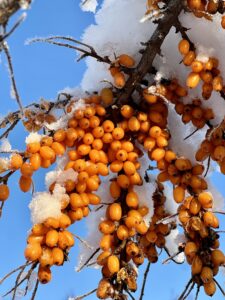





Snowy seaberries in Hiiumaa, Estonia. December 2023.
Sea buckthorn is a multifaceted resource. Its value extends beyond food and health products. Thanks to its unique chemical composition, broad range of uses, and environmental importance, sea buckthorn contributes to both human well-being and ecological balance. Furthermore, it supports sustainable agriculture by enhancing soil fertility and helping to prevent erosion. Due to its versatility, sea buckthorn is widely used in the food, medical, and cosmetic industries. As interest grows, its significance as a natural resource continues to increase.
Sources:
- Dubey, Roshan Kumar, Satyam Shukla, Vaishnavi Shukla, Sumit Singh. 2024. Sea buckthorn: A potential dietary supplement with multifaceted therapeutic activities. Intelligent Pharmacy 2: 681–687
- Li, Thomas S., Ryan W. Schroeder. 1996. Sea Buckthorn (Hippophae rhamnoides L.): A Multipurpose Plant. Horticultural Technology. 6(4): 370-380.
- Skalski, Olas B, Ulanowska K. 2018. The Anticancer Activity of Sea Buckthorn [Elaeagnus rhamnoides (L.) A. Nelson]. Front Pharmacol. 15(9): 232.
- Suryakumar, Geetha, Asheesh Gupta. 2011. Medicinal and therapeutic potential of Sea buckthorn (Hippophae rhamnoides L.). Journal of Ethnopharmacology. 138(2): 268-78.
- Tredici, Peter Del. 1995. A Nitrogen Fixation: The Story of the Frankia Symbiosis. Arnoldia. 55(4): 26–31.

